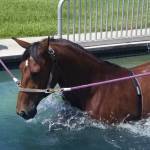Swimming for Horses: Yea or Whoa?

Training horses for competition comes in all forms, often dependent on a trainer’s preferences as well as past successes and failures. Trainers sometimes integrate swimming into their training protocols. Is swimming beneficial adjunct exercise?
“Cross-training that incorporates swimming is not a new concept, yet the science supporting when and how to integrate this technique remains controversial,” said Laura Petroski-Rose, B.V.M.S., a Kentucky Equine Research veterinarian.
Reported benefits of swimming for horses include:
- Facilitating rehabilitation following injury;
- Improved cardiovascular and respiratory parameters;
- Enhanced insulin-glucose metabolism;
- Alterations in skeletal muscle fiber composition indicating improved fitness;
- Reduced chance of musculoskeletal injuries; and
- Mental stimulation.
“The downside to swimming includes the potential for swimming-induced colic, skin issues or dermatitis secondary to moisture, and even risk of drowning,” relayed Petroski-Rose.
To better understand when, how, and why to implement swimming and what type of outcome to expect in specific situations, researchers collected data from 270 Standardbred trainers*.
According to the researchers, “swimming appears to be the most widely used form of cross-training, and therefore a better understanding of its role is needed…to determine the benefits, if any, of swimming exercise for racing success and longevity; effects of variations in intensity, duration, repetition and frequency; and how to best incorporate swimming into a horse’s training program. This knowledge could be important for performance but also for the welfare of horses.”
The primary reasons for swimming “were to replace track work for horses with limb injuries (79.4%), improve or maintain fitness (62.7%), and provide mental stimulation through variety in training (40.0%).”
Specifically, swimming also reportedly benefits horses with osteoarthritis, providing a way to keep joints mobile without bearing weight.
“Offering horses a joint supplement will also help lubricate those structures, keeping horses comfortable as they age,” advised Petroski-Rose.
She added, “Kentucky Equine Research offers several high-quality supplements, including KER-Flex (Glucos-A-Flex in Australia), Synovate HA, and EO-3.”
*Steel, C.M., B.M. Bond, A.V. Morrice-West. 2019. Survey of trainers on the use of swimming exercise for Standardbred racehorses in Australia. Australian Veterinary Journal. 97(3):61-67.








